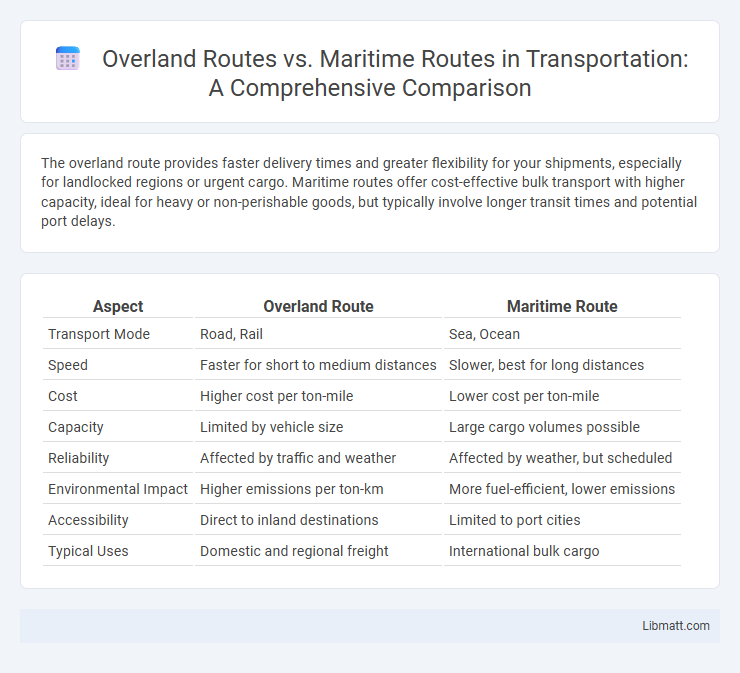The overland route provides faster delivery times and greater flexibility for your shipments, especially for landlocked regions or urgent cargo. Maritime routes offer cost-effective bulk transport with higher capacity, ideal for heavy or non-perishable goods, but typically involve longer transit times and potential port delays.
Table of Comparison
| Aspect | Overland Route | Maritime Route |
|---|---|---|
| Transport Mode | Road, Rail | Sea, Ocean |
| Speed | Faster for short to medium distances | Slower, best for long distances |
| Cost | Higher cost per ton-mile | Lower cost per ton-mile |
| Capacity | Limited by vehicle size | Large cargo volumes possible |
| Reliability | Affected by traffic and weather | Affected by weather, but scheduled |
| Environmental Impact | Higher emissions per ton-km | More fuel-efficient, lower emissions |
| Accessibility | Direct to inland destinations | Limited to port cities |
| Typical Uses | Domestic and regional freight | International bulk cargo |
Overview of Overland and Maritime Routes
The Overland Route offers a faster connection by land, linking major cities through highways and railways, ideal for time-sensitive cargo and shorter transit distances. Maritime Routes utilize vast ocean networks, enabling the transport of large volumes of goods at a lower cost but with longer transit times, suitable for heavy or bulky shipments. Your choice between these routes depends on balancing speed, cost, and cargo type for efficient supply chain management.
Historical Significance of Trade Routes
The Overland Route, famously marked by the Silk Road, played a critical role in connecting Asia and Europe, facilitating not only the exchange of silk, spices, and precious metals but also the spread of cultures and ideas. Maritime routes, including the ancient Indian Ocean trade network, revolutionized global commerce by enabling larger cargo shipments and year-round navigation, significantly boosting economic ties among Africa, Asia, and Europe. Understanding these trade routes helps you appreciate their immense impact on historical globalization and the development of modern trade systems.
Key Geographical Pathways
The Overland Route primarily traverses the Eurasian landmass, connecting East Asia to Europe through Central Asia's mountain passes, deserts, and river valleys, such as the historic Silk Road corridors. The Maritime Route follows crucial sea lanes spanning from the South China Sea through the Indian Ocean to the Mediterranean, capitalizing on natural chokepoints like the Strait of Malacca and the Suez Canal. Your choice between these routes influences factors like transit time, geopolitical risks, and accessibility to major economic hubs along these key geographical pathways.
Major Goods Transported
The Overland Route primarily transports high-value, time-sensitive goods such as electronics, automotive parts, and perishables due to faster transit times. The Maritime Route is ideal for bulk commodities like coal, oil, grain, and manufactured goods, accommodating larger volumes at lower costs. Your choice between these routes depends on balancing delivery speed with cargo type and cost-efficiency.
Cost Efficiency Comparison
The Overland Route often incurs higher transportation costs due to fuel expenses, tolls, and labor compared to the Maritime Route, which benefits from economies of scale and lower per-unit shipping rates. Maritime shipping can reduce overall logistics expenses by handling large volumes over long distances more cost-effectively. However, the Overland Route may offer faster delivery times and flexible scheduling, impacting the total cost-efficiency in time-sensitive supply chains.
Time and Speed Analysis
The Overland Route significantly reduces transit time compared to the Maritime Route, with shipments often arriving days or even weeks faster due to direct land connections and fewer delays at sea. Overland transport systems, such as rail or trucking, maintain higher average speeds and predictable schedules, optimizing delivery time for time-sensitive cargo. Your choice of route impacts supply chain efficiency by balancing cost with expedited delivery needs, making overland options ideal for faster turnaround.
Environmental Impact
The Overland Route typically results in higher carbon emissions due to reliance on diesel-powered trucks and trains, contributing significantly to air pollution and greenhouse gas accumulation. In contrast, the Maritime Route offers a lower environmental footprint per ton-kilometer, as modern cargo ships utilize more fuel-efficient engines and can transport vast amounts of goods simultaneously. Despite slower transit times, the shipping industry's ongoing adoption of cleaner technologies and alternative fuels further reduces its overall environmental impact compared to overland freight transport.
Security and Risk Factors
The Overland Route presents higher security risks due to political instability, border controls, and potential theft along multiple countries. In contrast, the Maritime Route offers more secure and controlled shipping environments but faces risks from piracy and adverse weather conditions. Both routes require robust risk management strategies tailored to geographic and regulatory challenges to ensure cargo safety.
Modern Infrastructure Developments
Modern infrastructure developments in the Overland Route include advanced rail networks like China's Belt and Road Initiative, enhancing connectivity through high-speed rail and improved logistics hubs. Maritime Route improvements focus on port expansions, deepening of shipping channels, and deployment of automated systems in major ports such as Singapore and Rotterdam. Both routes increasingly incorporate digital tracking and smart infrastructure to optimize cargo handling and reduce transit times.
Future Trends in Global Logistics
Overland routes are expected to play a pivotal role in future global logistics due to faster transit times and growing investments in rail infrastructure, especially across Eurasian corridors like the China-Europe rail link. Maritime routes will continue to dominate bulk cargo transport but face increasing pressure to adopt greener technologies and improve port efficiency to meet sustainability goals. Optimizing your supply chain will likely require a hybrid approach, leveraging the speed of overland transport and the cost-effectiveness of maritime shipping.
Overland Route vs Maritime Route Infographic

 libmatt.com
libmatt.com